The Significance of L&D in Organizational Change Management Processes
VerifiedAdded on 2021/11/09
|11
|2711
|24
Essay
AI Summary
This essay delves into the critical role of Learning and Development (L&D) in successful Change Management within organizations. It highlights how L&D empowers employees by providing them with the necessary skills, knowledge, and attitudes to adapt to organizational changes, such as new technologies or revised strategies. The essay emphasizes that effective change management requires a proactive approach that involves employees in the process, fostering a learning culture, and addressing potential resistance. It explores how L&D initiatives, including training programs and skill development, contribute to a smoother transition, increased employee engagement, and improved organizational outcomes. The essay also covers the importance of aligning L&D with the organization's vision and objectives to ensure that employees understand the need for change and their roles in the process. Finally, the essay underscores how L&D helps organizations create a stable environment during transitions, manage employee weaknesses, and drive innovation. The essay argues that a strategic focus on L&D is essential for navigating the dynamic business environment and achieving sustainable organizational success.
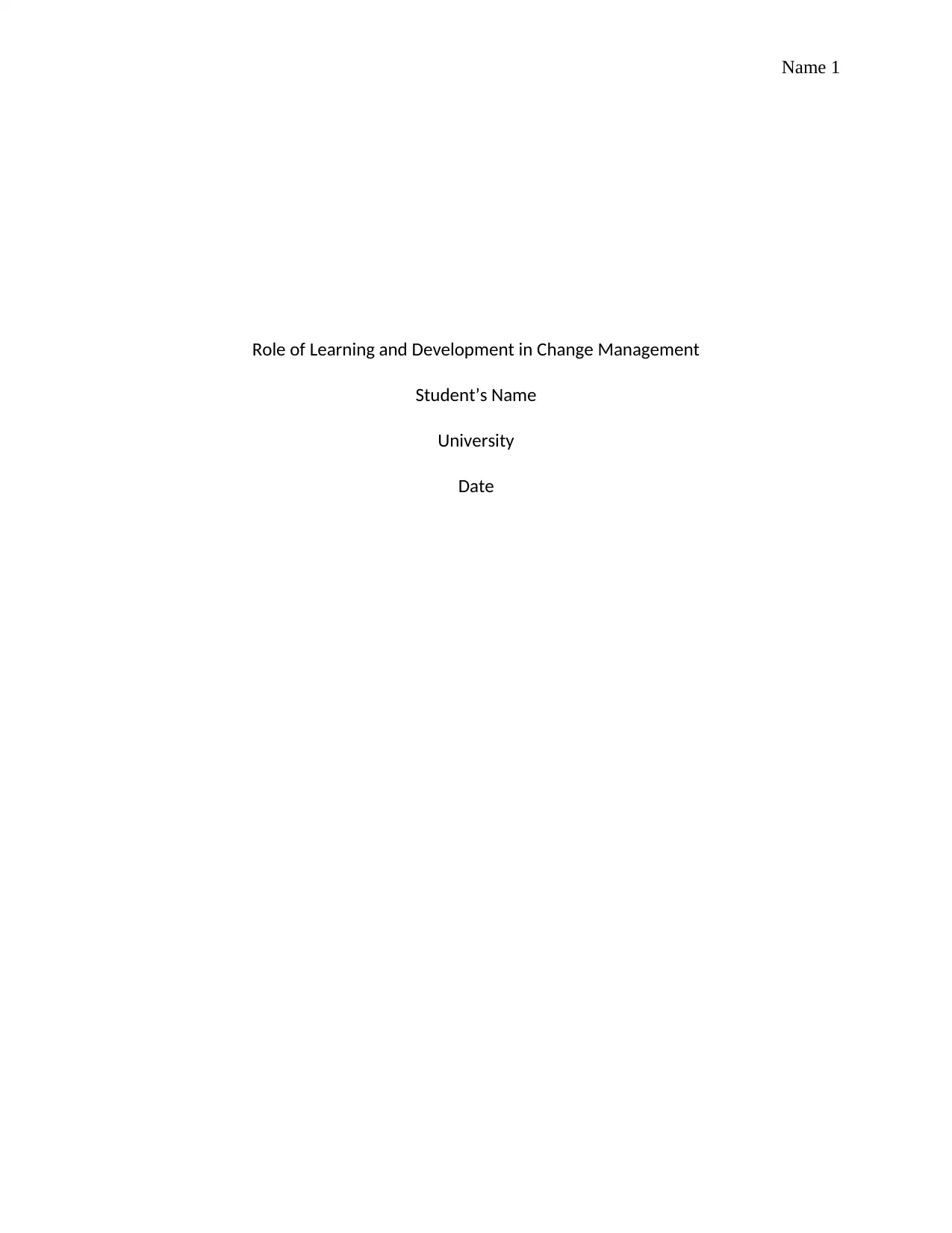
Name 1
Role of Learning and Development in Change Management
Student’s Name
University
Date
Role of Learning and Development in Change Management
Student’s Name
University
Date
Paraphrase This Document
Need a fresh take? Get an instant paraphrase of this document with our AI Paraphraser
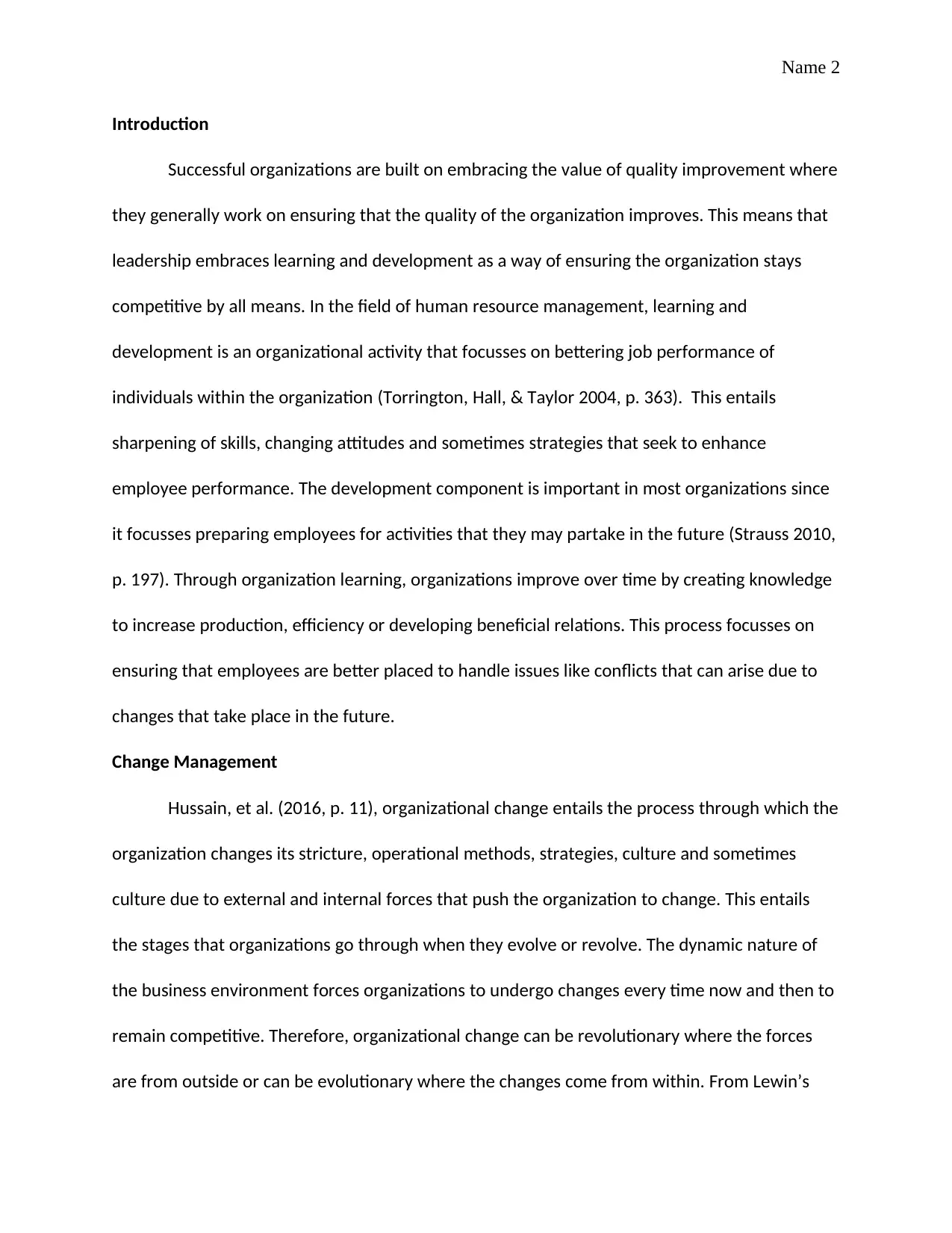
Name 2
Introduction
Successful organizations are built on embracing the value of quality improvement where
they generally work on ensuring that the quality of the organization improves. This means that
leadership embraces learning and development as a way of ensuring the organization stays
competitive by all means. In the field of human resource management, learning and
development is an organizational activity that focusses on bettering job performance of
individuals within the organization (Torrington, Hall, & Taylor 2004, p. 363). This entails
sharpening of skills, changing attitudes and sometimes strategies that seek to enhance
employee performance. The development component is important in most organizations since
it focusses preparing employees for activities that they may partake in the future (Strauss 2010,
p. 197). Through organization learning, organizations improve over time by creating knowledge
to increase production, efficiency or developing beneficial relations. This process focusses on
ensuring that employees are better placed to handle issues like conflicts that can arise due to
changes that take place in the future.
Change Management
Hussain, et al. (2016, p. 11), organizational change entails the process through which the
organization changes its stricture, operational methods, strategies, culture and sometimes
culture due to external and internal forces that push the organization to change. This entails
the stages that organizations go through when they evolve or revolve. The dynamic nature of
the business environment forces organizations to undergo changes every time now and then to
remain competitive. Therefore, organizational change can be revolutionary where the forces
are from outside or can be evolutionary where the changes come from within. From Lewin’s
Introduction
Successful organizations are built on embracing the value of quality improvement where
they generally work on ensuring that the quality of the organization improves. This means that
leadership embraces learning and development as a way of ensuring the organization stays
competitive by all means. In the field of human resource management, learning and
development is an organizational activity that focusses on bettering job performance of
individuals within the organization (Torrington, Hall, & Taylor 2004, p. 363). This entails
sharpening of skills, changing attitudes and sometimes strategies that seek to enhance
employee performance. The development component is important in most organizations since
it focusses preparing employees for activities that they may partake in the future (Strauss 2010,
p. 197). Through organization learning, organizations improve over time by creating knowledge
to increase production, efficiency or developing beneficial relations. This process focusses on
ensuring that employees are better placed to handle issues like conflicts that can arise due to
changes that take place in the future.
Change Management
Hussain, et al. (2016, p. 11), organizational change entails the process through which the
organization changes its stricture, operational methods, strategies, culture and sometimes
culture due to external and internal forces that push the organization to change. This entails
the stages that organizations go through when they evolve or revolve. The dynamic nature of
the business environment forces organizations to undergo changes every time now and then to
remain competitive. Therefore, organizational change can be revolutionary where the forces
are from outside or can be evolutionary where the changes come from within. From Lewin’s
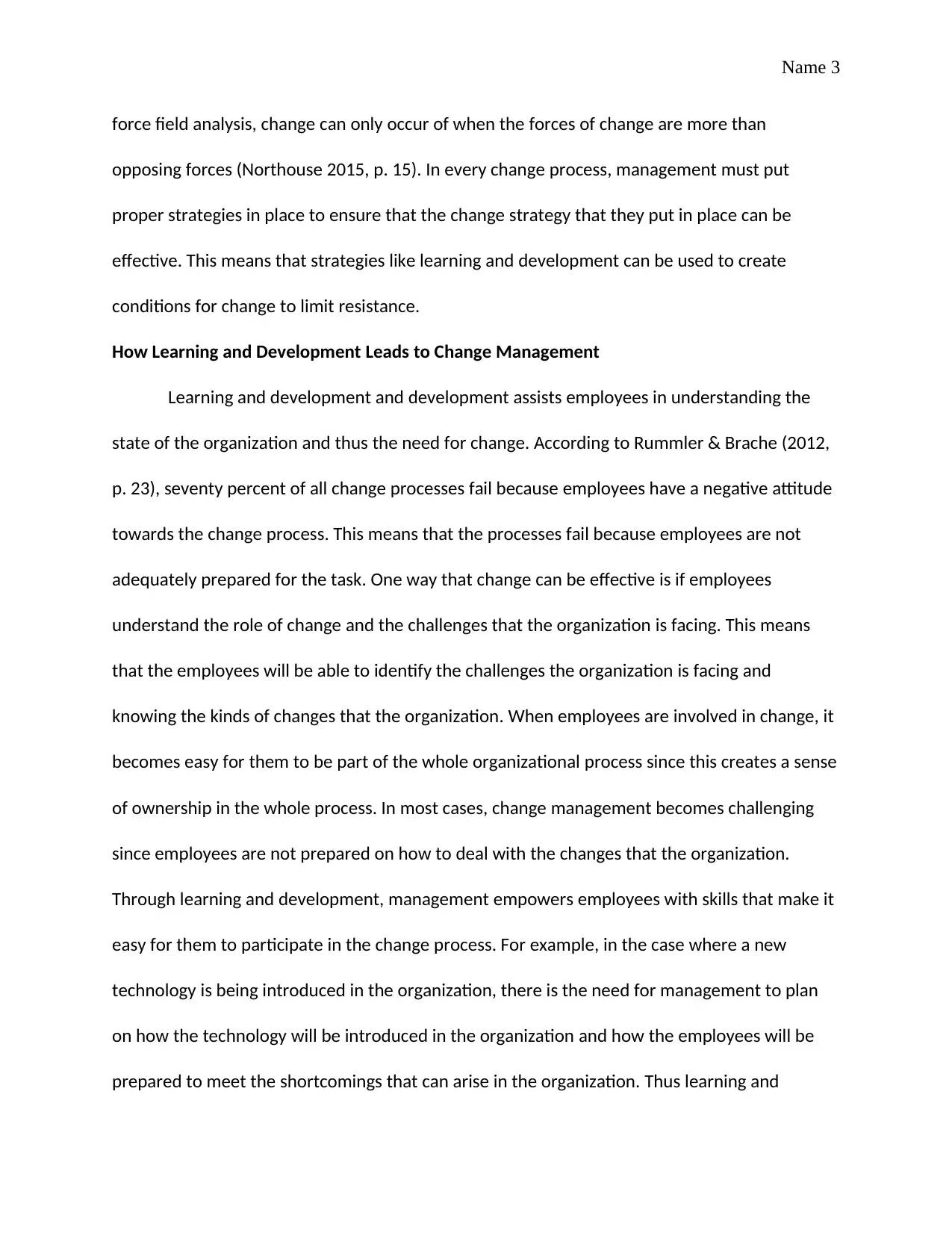
Name 3
force field analysis, change can only occur of when the forces of change are more than
opposing forces (Northouse 2015, p. 15). In every change process, management must put
proper strategies in place to ensure that the change strategy that they put in place can be
effective. This means that strategies like learning and development can be used to create
conditions for change to limit resistance.
How Learning and Development Leads to Change Management
Learning and development and development assists employees in understanding the
state of the organization and thus the need for change. According to Rummler & Brache (2012,
p. 23), seventy percent of all change processes fail because employees have a negative attitude
towards the change process. This means that the processes fail because employees are not
adequately prepared for the task. One way that change can be effective is if employees
understand the role of change and the challenges that the organization is facing. This means
that the employees will be able to identify the challenges the organization is facing and
knowing the kinds of changes that the organization. When employees are involved in change, it
becomes easy for them to be part of the whole organizational process since this creates a sense
of ownership in the whole process. In most cases, change management becomes challenging
since employees are not prepared on how to deal with the changes that the organization.
Through learning and development, management empowers employees with skills that make it
easy for them to participate in the change process. For example, in the case where a new
technology is being introduced in the organization, there is the need for management to plan
on how the technology will be introduced in the organization and how the employees will be
prepared to meet the shortcomings that can arise in the organization. Thus learning and
force field analysis, change can only occur of when the forces of change are more than
opposing forces (Northouse 2015, p. 15). In every change process, management must put
proper strategies in place to ensure that the change strategy that they put in place can be
effective. This means that strategies like learning and development can be used to create
conditions for change to limit resistance.
How Learning and Development Leads to Change Management
Learning and development and development assists employees in understanding the
state of the organization and thus the need for change. According to Rummler & Brache (2012,
p. 23), seventy percent of all change processes fail because employees have a negative attitude
towards the change process. This means that the processes fail because employees are not
adequately prepared for the task. One way that change can be effective is if employees
understand the role of change and the challenges that the organization is facing. This means
that the employees will be able to identify the challenges the organization is facing and
knowing the kinds of changes that the organization. When employees are involved in change, it
becomes easy for them to be part of the whole organizational process since this creates a sense
of ownership in the whole process. In most cases, change management becomes challenging
since employees are not prepared on how to deal with the changes that the organization.
Through learning and development, management empowers employees with skills that make it
easy for them to participate in the change process. For example, in the case where a new
technology is being introduced in the organization, there is the need for management to plan
on how the technology will be introduced in the organization and how the employees will be
prepared to meet the shortcomings that can arise in the organization. Thus learning and
⊘ This is a preview!⊘
Do you want full access?
Subscribe today to unlock all pages.

Trusted by 1+ million students worldwide
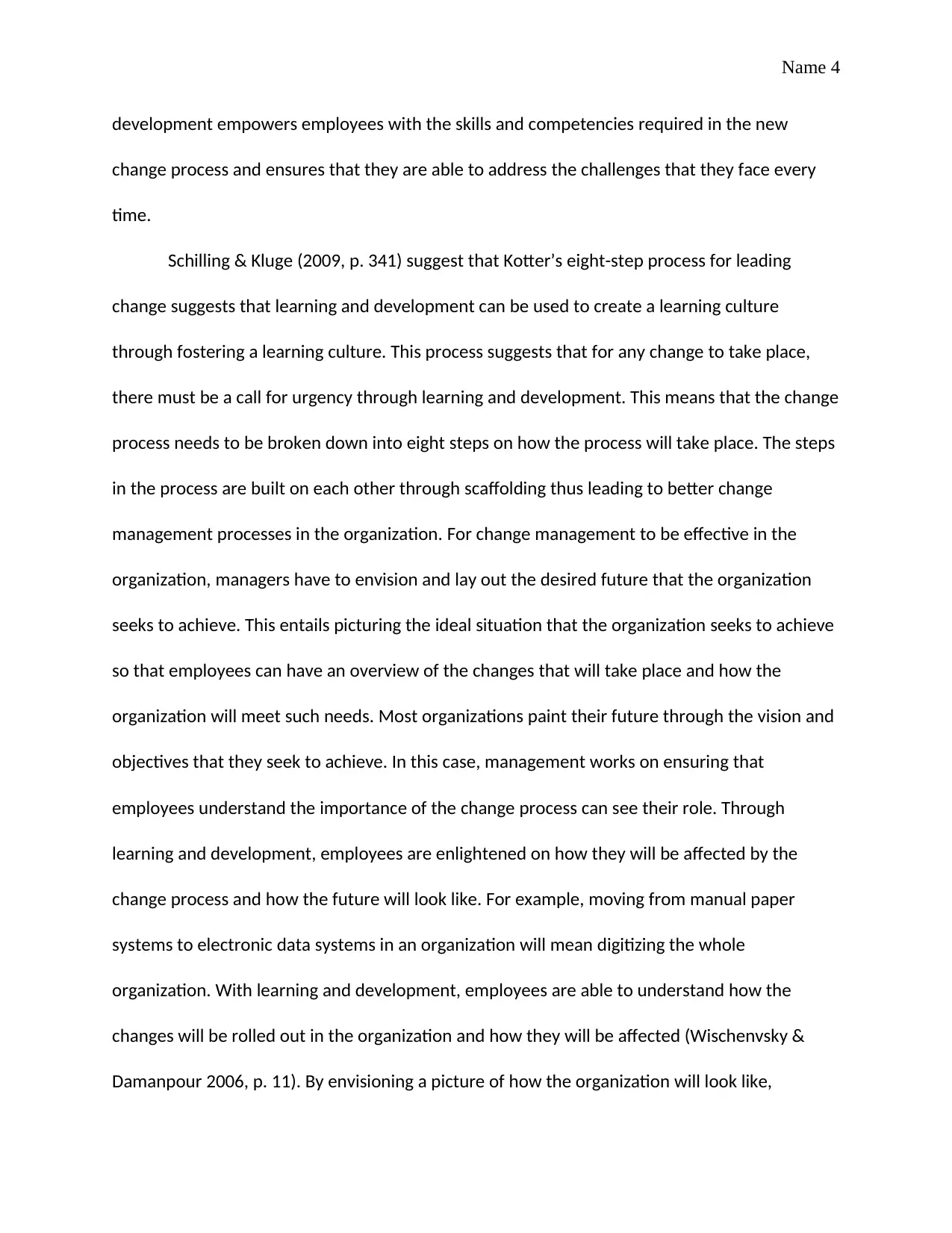
Name 4
development empowers employees with the skills and competencies required in the new
change process and ensures that they are able to address the challenges that they face every
time.
Schilling & Kluge (2009, p. 341) suggest that Kotter’s eight-step process for leading
change suggests that learning and development can be used to create a learning culture
through fostering a learning culture. This process suggests that for any change to take place,
there must be a call for urgency through learning and development. This means that the change
process needs to be broken down into eight steps on how the process will take place. The steps
in the process are built on each other through scaffolding thus leading to better change
management processes in the organization. For change management to be effective in the
organization, managers have to envision and lay out the desired future that the organization
seeks to achieve. This entails picturing the ideal situation that the organization seeks to achieve
so that employees can have an overview of the changes that will take place and how the
organization will meet such needs. Most organizations paint their future through the vision and
objectives that they seek to achieve. In this case, management works on ensuring that
employees understand the importance of the change process can see their role. Through
learning and development, employees are enlightened on how they will be affected by the
change process and how the future will look like. For example, moving from manual paper
systems to electronic data systems in an organization will mean digitizing the whole
organization. With learning and development, employees are able to understand how the
changes will be rolled out in the organization and how they will be affected (Wischenvsky &
Damanpour 2006, p. 11). By envisioning a picture of how the organization will look like,
development empowers employees with the skills and competencies required in the new
change process and ensures that they are able to address the challenges that they face every
time.
Schilling & Kluge (2009, p. 341) suggest that Kotter’s eight-step process for leading
change suggests that learning and development can be used to create a learning culture
through fostering a learning culture. This process suggests that for any change to take place,
there must be a call for urgency through learning and development. This means that the change
process needs to be broken down into eight steps on how the process will take place. The steps
in the process are built on each other through scaffolding thus leading to better change
management processes in the organization. For change management to be effective in the
organization, managers have to envision and lay out the desired future that the organization
seeks to achieve. This entails picturing the ideal situation that the organization seeks to achieve
so that employees can have an overview of the changes that will take place and how the
organization will meet such needs. Most organizations paint their future through the vision and
objectives that they seek to achieve. In this case, management works on ensuring that
employees understand the importance of the change process can see their role. Through
learning and development, employees are enlightened on how they will be affected by the
change process and how the future will look like. For example, moving from manual paper
systems to electronic data systems in an organization will mean digitizing the whole
organization. With learning and development, employees are able to understand how the
changes will be rolled out in the organization and how they will be affected (Wischenvsky &
Damanpour 2006, p. 11). By envisioning a picture of how the organization will look like,
Paraphrase This Document
Need a fresh take? Get an instant paraphrase of this document with our AI Paraphraser
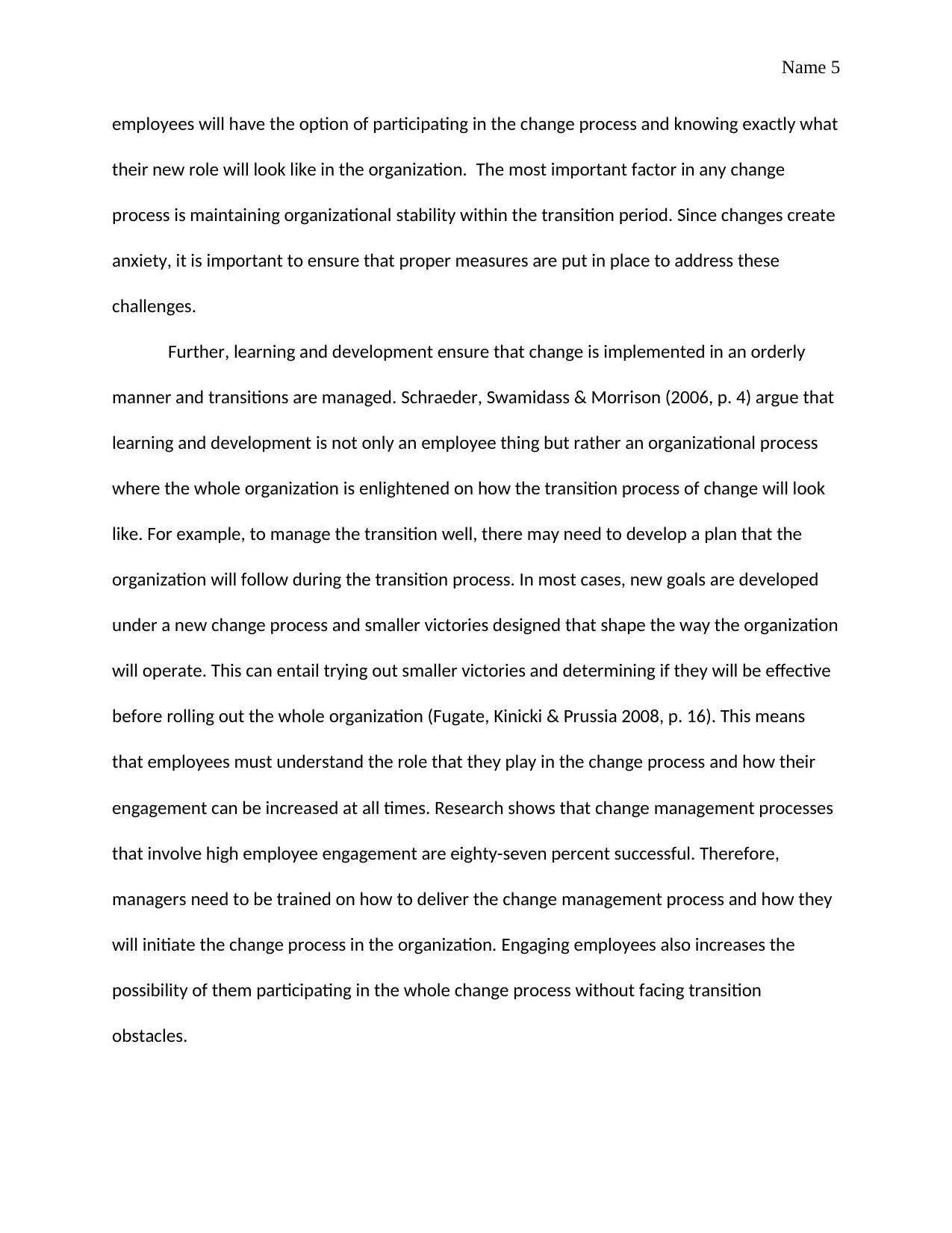
Name 5
employees will have the option of participating in the change process and knowing exactly what
their new role will look like in the organization. The most important factor in any change
process is maintaining organizational stability within the transition period. Since changes create
anxiety, it is important to ensure that proper measures are put in place to address these
challenges.
Further, learning and development ensure that change is implemented in an orderly
manner and transitions are managed. Schraeder, Swamidass & Morrison (2006, p. 4) argue that
learning and development is not only an employee thing but rather an organizational process
where the whole organization is enlightened on how the transition process of change will look
like. For example, to manage the transition well, there may need to develop a plan that the
organization will follow during the transition process. In most cases, new goals are developed
under a new change process and smaller victories designed that shape the way the organization
will operate. This can entail trying out smaller victories and determining if they will be effective
before rolling out the whole organization (Fugate, Kinicki & Prussia 2008, p. 16). This means
that employees must understand the role that they play in the change process and how their
engagement can be increased at all times. Research shows that change management processes
that involve high employee engagement are eighty-seven percent successful. Therefore,
managers need to be trained on how to deliver the change management process and how they
will initiate the change process in the organization. Engaging employees also increases the
possibility of them participating in the whole change process without facing transition
obstacles.
employees will have the option of participating in the change process and knowing exactly what
their new role will look like in the organization. The most important factor in any change
process is maintaining organizational stability within the transition period. Since changes create
anxiety, it is important to ensure that proper measures are put in place to address these
challenges.
Further, learning and development ensure that change is implemented in an orderly
manner and transitions are managed. Schraeder, Swamidass & Morrison (2006, p. 4) argue that
learning and development is not only an employee thing but rather an organizational process
where the whole organization is enlightened on how the transition process of change will look
like. For example, to manage the transition well, there may need to develop a plan that the
organization will follow during the transition process. In most cases, new goals are developed
under a new change process and smaller victories designed that shape the way the organization
will operate. This can entail trying out smaller victories and determining if they will be effective
before rolling out the whole organization (Fugate, Kinicki & Prussia 2008, p. 16). This means
that employees must understand the role that they play in the change process and how their
engagement can be increased at all times. Research shows that change management processes
that involve high employee engagement are eighty-seven percent successful. Therefore,
managers need to be trained on how to deliver the change management process and how they
will initiate the change process in the organization. Engaging employees also increases the
possibility of them participating in the whole change process without facing transition
obstacles.
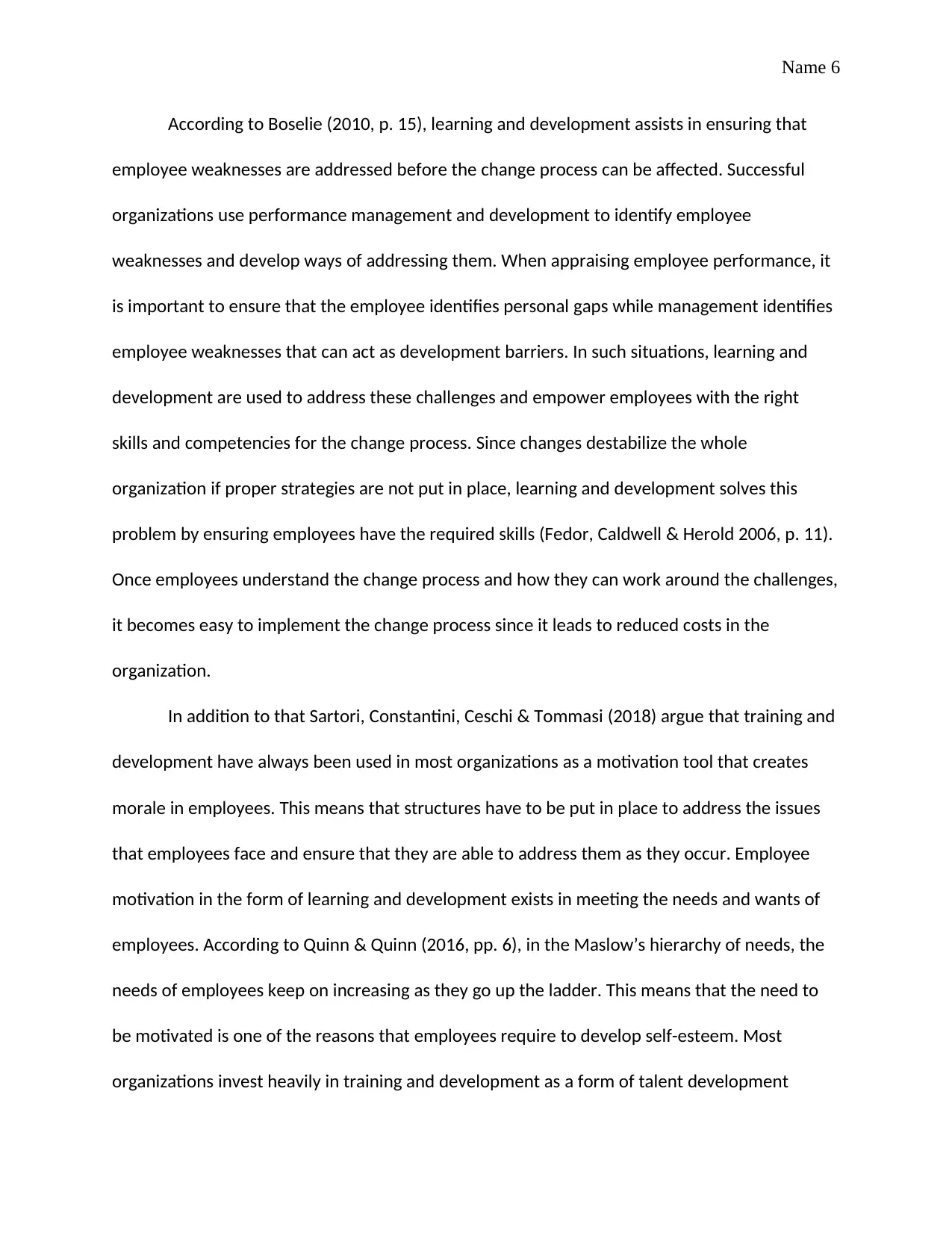
Name 6
According to Boselie (2010, p. 15), learning and development assists in ensuring that
employee weaknesses are addressed before the change process can be affected. Successful
organizations use performance management and development to identify employee
weaknesses and develop ways of addressing them. When appraising employee performance, it
is important to ensure that the employee identifies personal gaps while management identifies
employee weaknesses that can act as development barriers. In such situations, learning and
development are used to address these challenges and empower employees with the right
skills and competencies for the change process. Since changes destabilize the whole
organization if proper strategies are not put in place, learning and development solves this
problem by ensuring employees have the required skills (Fedor, Caldwell & Herold 2006, p. 11).
Once employees understand the change process and how they can work around the challenges,
it becomes easy to implement the change process since it leads to reduced costs in the
organization.
In addition to that Sartori, Constantini, Ceschi & Tommasi (2018) argue that training and
development have always been used in most organizations as a motivation tool that creates
morale in employees. This means that structures have to be put in place to address the issues
that employees face and ensure that they are able to address them as they occur. Employee
motivation in the form of learning and development exists in meeting the needs and wants of
employees. According to Quinn & Quinn (2016, pp. 6), in the Maslow’s hierarchy of needs, the
needs of employees keep on increasing as they go up the ladder. This means that the need to
be motivated is one of the reasons that employees require to develop self-esteem. Most
organizations invest heavily in training and development as a form of talent development
According to Boselie (2010, p. 15), learning and development assists in ensuring that
employee weaknesses are addressed before the change process can be affected. Successful
organizations use performance management and development to identify employee
weaknesses and develop ways of addressing them. When appraising employee performance, it
is important to ensure that the employee identifies personal gaps while management identifies
employee weaknesses that can act as development barriers. In such situations, learning and
development are used to address these challenges and empower employees with the right
skills and competencies for the change process. Since changes destabilize the whole
organization if proper strategies are not put in place, learning and development solves this
problem by ensuring employees have the required skills (Fedor, Caldwell & Herold 2006, p. 11).
Once employees understand the change process and how they can work around the challenges,
it becomes easy to implement the change process since it leads to reduced costs in the
organization.
In addition to that Sartori, Constantini, Ceschi & Tommasi (2018) argue that training and
development have always been used in most organizations as a motivation tool that creates
morale in employees. This means that structures have to be put in place to address the issues
that employees face and ensure that they are able to address them as they occur. Employee
motivation in the form of learning and development exists in meeting the needs and wants of
employees. According to Quinn & Quinn (2016, pp. 6), in the Maslow’s hierarchy of needs, the
needs of employees keep on increasing as they go up the ladder. This means that the need to
be motivated is one of the reasons that employees require to develop self-esteem. Most
organizations invest heavily in training and development as a form of talent development
⊘ This is a preview!⊘
Do you want full access?
Subscribe today to unlock all pages.

Trusted by 1+ million students worldwide
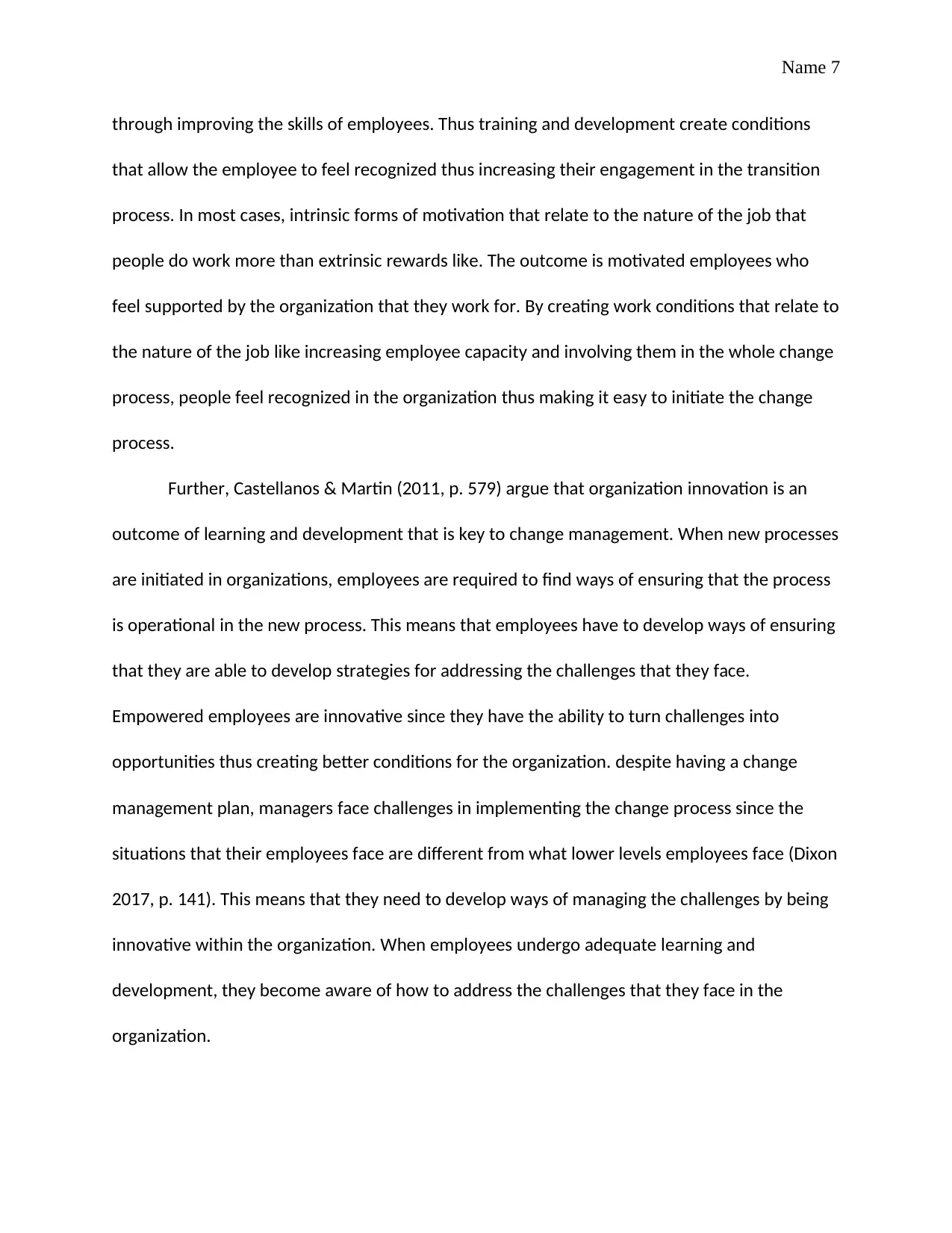
Name 7
through improving the skills of employees. Thus training and development create conditions
that allow the employee to feel recognized thus increasing their engagement in the transition
process. In most cases, intrinsic forms of motivation that relate to the nature of the job that
people do work more than extrinsic rewards like. The outcome is motivated employees who
feel supported by the organization that they work for. By creating work conditions that relate to
the nature of the job like increasing employee capacity and involving them in the whole change
process, people feel recognized in the organization thus making it easy to initiate the change
process.
Further, Castellanos & Martin (2011, p. 579) argue that organization innovation is an
outcome of learning and development that is key to change management. When new processes
are initiated in organizations, employees are required to find ways of ensuring that the process
is operational in the new process. This means that employees have to develop ways of ensuring
that they are able to develop strategies for addressing the challenges that they face.
Empowered employees are innovative since they have the ability to turn challenges into
opportunities thus creating better conditions for the organization. despite having a change
management plan, managers face challenges in implementing the change process since the
situations that their employees face are different from what lower levels employees face (Dixon
2017, p. 141). This means that they need to develop ways of managing the challenges by being
innovative within the organization. When employees undergo adequate learning and
development, they become aware of how to address the challenges that they face in the
organization.
through improving the skills of employees. Thus training and development create conditions
that allow the employee to feel recognized thus increasing their engagement in the transition
process. In most cases, intrinsic forms of motivation that relate to the nature of the job that
people do work more than extrinsic rewards like. The outcome is motivated employees who
feel supported by the organization that they work for. By creating work conditions that relate to
the nature of the job like increasing employee capacity and involving them in the whole change
process, people feel recognized in the organization thus making it easy to initiate the change
process.
Further, Castellanos & Martin (2011, p. 579) argue that organization innovation is an
outcome of learning and development that is key to change management. When new processes
are initiated in organizations, employees are required to find ways of ensuring that the process
is operational in the new process. This means that employees have to develop ways of ensuring
that they are able to develop strategies for addressing the challenges that they face.
Empowered employees are innovative since they have the ability to turn challenges into
opportunities thus creating better conditions for the organization. despite having a change
management plan, managers face challenges in implementing the change process since the
situations that their employees face are different from what lower levels employees face (Dixon
2017, p. 141). This means that they need to develop ways of managing the challenges by being
innovative within the organization. When employees undergo adequate learning and
development, they become aware of how to address the challenges that they face in the
organization.
Paraphrase This Document
Need a fresh take? Get an instant paraphrase of this document with our AI Paraphraser
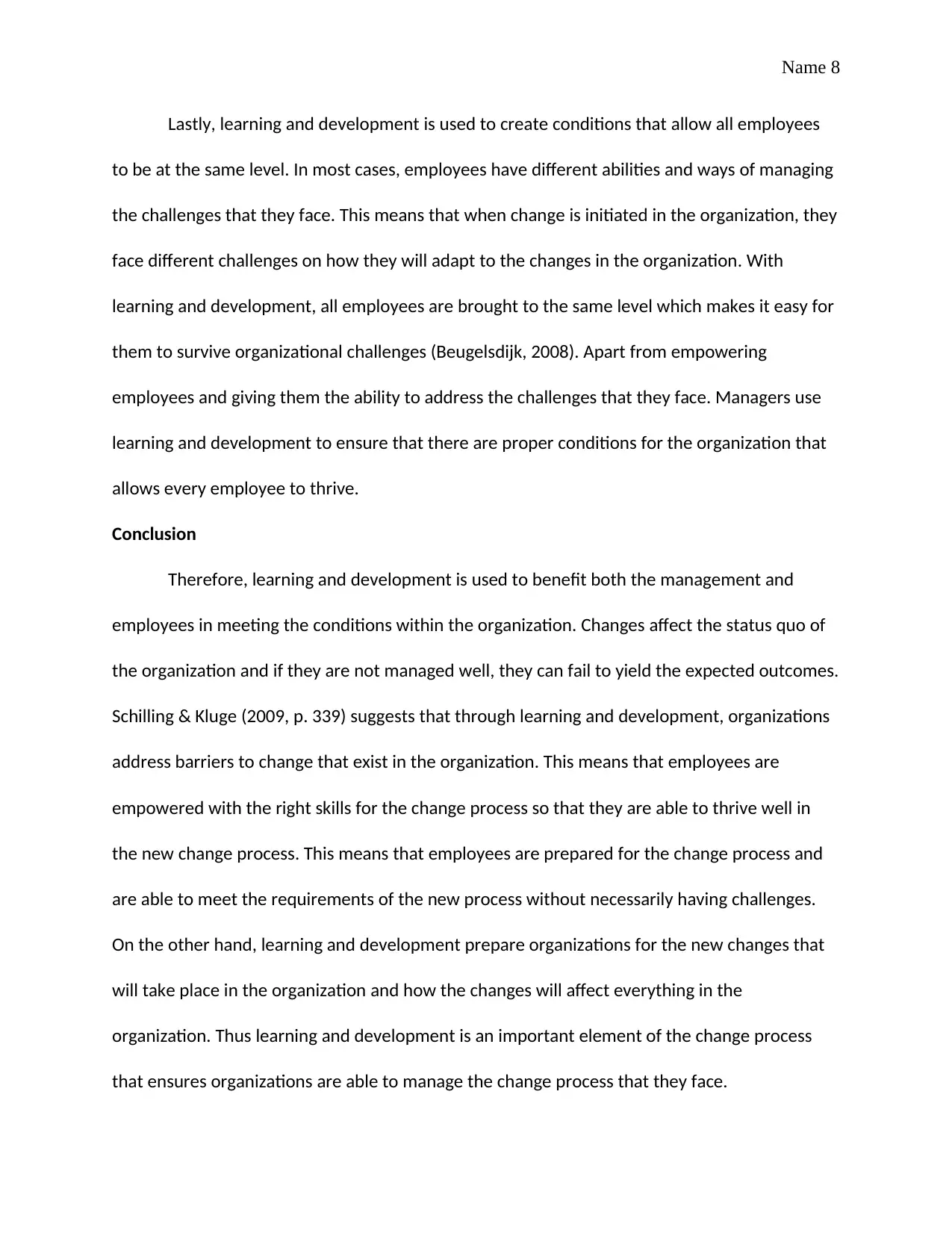
Name 8
Lastly, learning and development is used to create conditions that allow all employees
to be at the same level. In most cases, employees have different abilities and ways of managing
the challenges that they face. This means that when change is initiated in the organization, they
face different challenges on how they will adapt to the changes in the organization. With
learning and development, all employees are brought to the same level which makes it easy for
them to survive organizational challenges (Beugelsdijk, 2008). Apart from empowering
employees and giving them the ability to address the challenges that they face. Managers use
learning and development to ensure that there are proper conditions for the organization that
allows every employee to thrive.
Conclusion
Therefore, learning and development is used to benefit both the management and
employees in meeting the conditions within the organization. Changes affect the status quo of
the organization and if they are not managed well, they can fail to yield the expected outcomes.
Schilling & Kluge (2009, p. 339) suggests that through learning and development, organizations
address barriers to change that exist in the organization. This means that employees are
empowered with the right skills for the change process so that they are able to thrive well in
the new change process. This means that employees are prepared for the change process and
are able to meet the requirements of the new process without necessarily having challenges.
On the other hand, learning and development prepare organizations for the new changes that
will take place in the organization and how the changes will affect everything in the
organization. Thus learning and development is an important element of the change process
that ensures organizations are able to manage the change process that they face.
Lastly, learning and development is used to create conditions that allow all employees
to be at the same level. In most cases, employees have different abilities and ways of managing
the challenges that they face. This means that when change is initiated in the organization, they
face different challenges on how they will adapt to the changes in the organization. With
learning and development, all employees are brought to the same level which makes it easy for
them to survive organizational challenges (Beugelsdijk, 2008). Apart from empowering
employees and giving them the ability to address the challenges that they face. Managers use
learning and development to ensure that there are proper conditions for the organization that
allows every employee to thrive.
Conclusion
Therefore, learning and development is used to benefit both the management and
employees in meeting the conditions within the organization. Changes affect the status quo of
the organization and if they are not managed well, they can fail to yield the expected outcomes.
Schilling & Kluge (2009, p. 339) suggests that through learning and development, organizations
address barriers to change that exist in the organization. This means that employees are
empowered with the right skills for the change process so that they are able to thrive well in
the new change process. This means that employees are prepared for the change process and
are able to meet the requirements of the new process without necessarily having challenges.
On the other hand, learning and development prepare organizations for the new changes that
will take place in the organization and how the changes will affect everything in the
organization. Thus learning and development is an important element of the change process
that ensures organizations are able to manage the change process that they face.

Name 9
⊘ This is a preview!⊘
Do you want full access?
Subscribe today to unlock all pages.

Trusted by 1+ million students worldwide
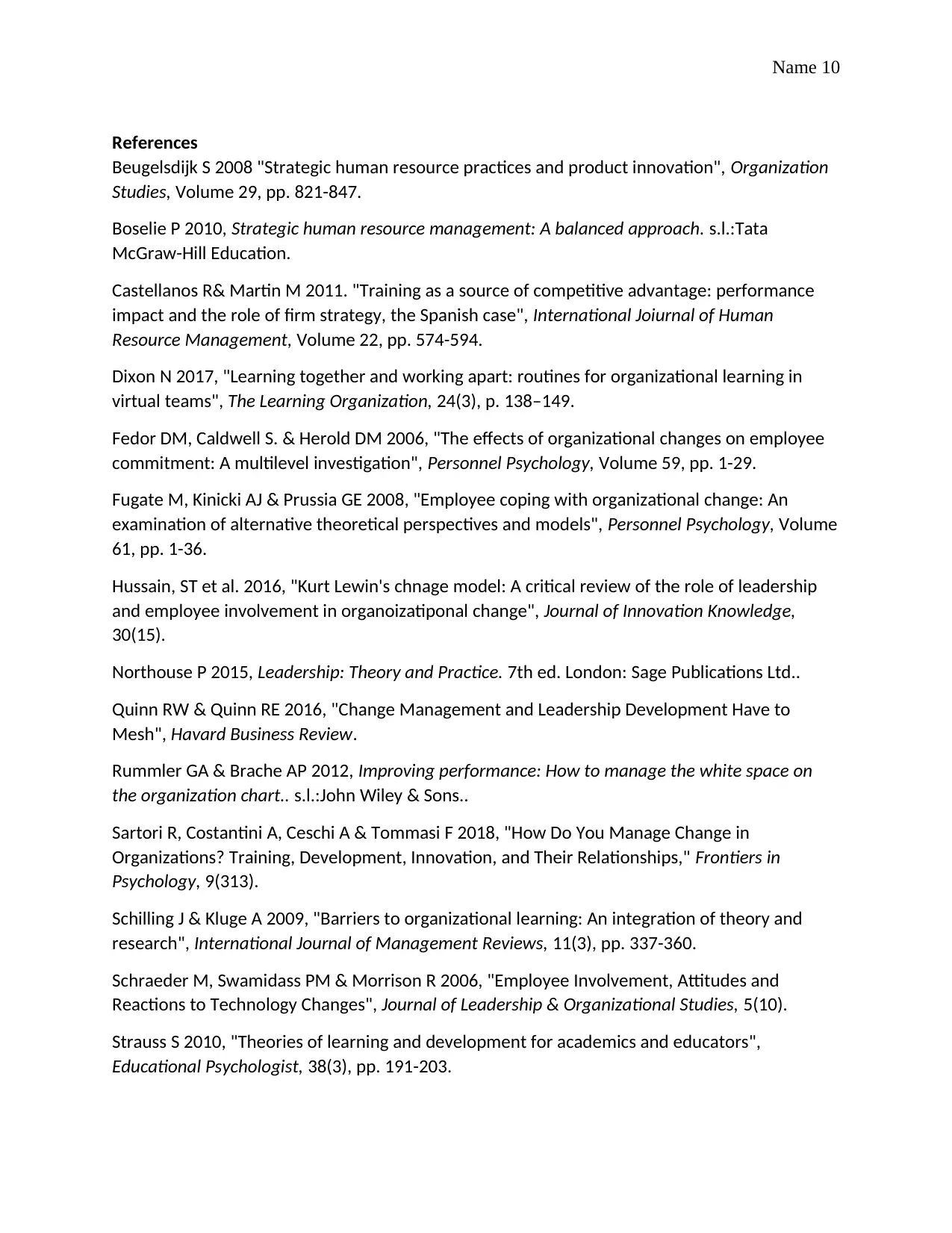
Name 10
References
Beugelsdijk S 2008 "Strategic human resource practices and product innovation", Organization
Studies, Volume 29, pp. 821-847.
Boselie P 2010, Strategic human resource management: A balanced approach. s.l.:Tata
McGraw-Hill Education.
Castellanos R& Martin M 2011. "Training as a source of competitive advantage: performance
impact and the role of firm strategy, the Spanish case", International Joiurnal of Human
Resource Management, Volume 22, pp. 574-594.
Dixon N 2017, "Learning together and working apart: routines for organizational learning in
virtual teams", The Learning Organization, 24(3), p. 138–149.
Fedor DM, Caldwell S. & Herold DM 2006, "The effects of organizational changes on employee
commitment: A multilevel investigation", Personnel Psychology, Volume 59, pp. 1-29.
Fugate M, Kinicki AJ & Prussia GE 2008, "Employee coping with organizational change: An
examination of alternative theoretical perspectives and models", Personnel Psychology, Volume
61, pp. 1-36.
Hussain, ST et al. 2016, "Kurt Lewin's chnage model: A critical review of the role of leadership
and employee involvement in organoizatiponal change", Journal of Innovation Knowledge,
30(15).
Northouse P 2015, Leadership: Theory and Practice. 7th ed. London: Sage Publications Ltd..
Quinn RW & Quinn RE 2016, "Change Management and Leadership Development Have to
Mesh", Havard Business Review.
Rummler GA & Brache AP 2012, Improving performance: How to manage the white space on
the organization chart.. s.l.:John Wiley & Sons..
Sartori R, Costantini A, Ceschi A & Tommasi F 2018, "How Do You Manage Change in
Organizations? Training, Development, Innovation, and Their Relationships," Frontiers in
Psychology, 9(313).
Schilling J & Kluge A 2009, "Barriers to organizational learning: An integration of theory and
research", International Journal of Management Reviews, 11(3), pp. 337-360.
Schraeder M, Swamidass PM & Morrison R 2006, "Employee Involvement, Attitudes and
Reactions to Technology Changes", Journal of Leadership & Organizational Studies, 5(10).
Strauss S 2010, "Theories of learning and development for academics and educators",
Educational Psychologist, 38(3), pp. 191-203.
References
Beugelsdijk S 2008 "Strategic human resource practices and product innovation", Organization
Studies, Volume 29, pp. 821-847.
Boselie P 2010, Strategic human resource management: A balanced approach. s.l.:Tata
McGraw-Hill Education.
Castellanos R& Martin M 2011. "Training as a source of competitive advantage: performance
impact and the role of firm strategy, the Spanish case", International Joiurnal of Human
Resource Management, Volume 22, pp. 574-594.
Dixon N 2017, "Learning together and working apart: routines for organizational learning in
virtual teams", The Learning Organization, 24(3), p. 138–149.
Fedor DM, Caldwell S. & Herold DM 2006, "The effects of organizational changes on employee
commitment: A multilevel investigation", Personnel Psychology, Volume 59, pp. 1-29.
Fugate M, Kinicki AJ & Prussia GE 2008, "Employee coping with organizational change: An
examination of alternative theoretical perspectives and models", Personnel Psychology, Volume
61, pp. 1-36.
Hussain, ST et al. 2016, "Kurt Lewin's chnage model: A critical review of the role of leadership
and employee involvement in organoizatiponal change", Journal of Innovation Knowledge,
30(15).
Northouse P 2015, Leadership: Theory and Practice. 7th ed. London: Sage Publications Ltd..
Quinn RW & Quinn RE 2016, "Change Management and Leadership Development Have to
Mesh", Havard Business Review.
Rummler GA & Brache AP 2012, Improving performance: How to manage the white space on
the organization chart.. s.l.:John Wiley & Sons..
Sartori R, Costantini A, Ceschi A & Tommasi F 2018, "How Do You Manage Change in
Organizations? Training, Development, Innovation, and Their Relationships," Frontiers in
Psychology, 9(313).
Schilling J & Kluge A 2009, "Barriers to organizational learning: An integration of theory and
research", International Journal of Management Reviews, 11(3), pp. 337-360.
Schraeder M, Swamidass PM & Morrison R 2006, "Employee Involvement, Attitudes and
Reactions to Technology Changes", Journal of Leadership & Organizational Studies, 5(10).
Strauss S 2010, "Theories of learning and development for academics and educators",
Educational Psychologist, 38(3), pp. 191-203.
Paraphrase This Document
Need a fresh take? Get an instant paraphrase of this document with our AI Paraphraser

Name 11
Torrington D, Hall L & Taylor S 2004, Human Resource Management. London: Pearson
Education.
Wischenvsky JD & Damanpour F 2006, "Organizational Transformation and Performance: An
examination of three perspectives". Journal of Managerial Issues, 4(3).
Torrington D, Hall L & Taylor S 2004, Human Resource Management. London: Pearson
Education.
Wischenvsky JD & Damanpour F 2006, "Organizational Transformation and Performance: An
examination of three perspectives". Journal of Managerial Issues, 4(3).
1 out of 11
Related Documents
Your All-in-One AI-Powered Toolkit for Academic Success.
+13062052269
info@desklib.com
Available 24*7 on WhatsApp / Email
![[object Object]](/_next/static/media/star-bottom.7253800d.svg)
Unlock your academic potential
Copyright © 2020–2025 A2Z Services. All Rights Reserved. Developed and managed by ZUCOL.




